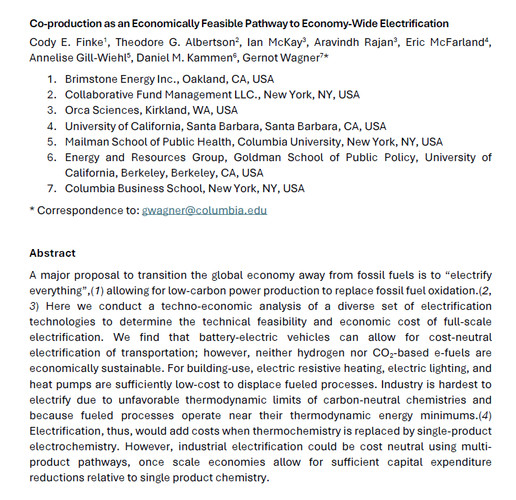Do We Really Have Only 12 Years to Avoid Climate Disaster?
By Gernot Wagner and Constantine Samaras
Twelve years is at once an eternity and right around the corner. Just ask any parent watching their kids grow up. So it hits home when a growing chorus of often young voices — from proponents of the Green New Deal to the global Youth Climate Strike — says forcefully that the world has 12 years left to avoid disastrous climate change. This is just the latest dire warning about time running out issued over the past 20 years. But this deadline is different — it’s both entirely wrong, and oh so right.
The idea of a 12-year deadline arose last fall with the release of a special report of the Intergovernmental Panel on Climate Change. The United Nations group of climate scientists from around the world said that if the planet’s governments want to limit global warming to 2.7 degrees Fahrenheit (1.5 degrees Celsius) above preindustrial temperatures, a mere 1 degree Fahrenheit above today’s levels, society will have to reduce its greenhouse gas emissions by about half by 2030, declining further to net zero by around midcentury. The “about” and “around” typically get dropped in translation, rendering the outcome falsely precise, especially in headlines about the report. The Guardian, for example, announced: “We have 12 years to limit climate change catastrophe, warns U.N.”
Now, of course, it would be 11 years.
Technically, this deadline is wrong, not least because it is much too precise. The world won’t end in 2030 if emissions don’t decline. The NASA climate scientist Kate Marvel summed it up perfectly: “Climate change isn’t a cliff we fall off, but a slope we slide down.”
That’s one of the many reasons climate change is such a difficult problem. There’s no obvious stop sign, no simple red line. The reverse is also true: There won’t be a superhero ending to this movie, a point when climate change will have been “solved.” Our children and grandchildren — and theirs — will be managing the impacts of climate change for decades and centuries to come.
Still, the equation is simple: fewer emissions equal a more hospitable climate. Rising average temperatures make extreme heat more likely, hurricanes and storms more intense and threaten fresh water supplies. Climate impacts have already started to hit.
Halving greenhouse gas emissions by 2030 would be a tall order, to say the least. Changes to infrastructure take a long time. Cars on the road today are on average about 12 years old, and a new car sold in 2020 could still be on the road in 2040 or later. Power plants are built to stay in service much longer. There are a few coal-fired electric power plants in the United States that first began operation in the 1950s and are still producing electricity today. The inherent inertia that society is up against makes a climate action deadline of about a decade not just a sensible option, but an imperative.
We need to speed up the transition to clean and efficient transportation, electricity, industry, agriculture and buildings, and also make infrastructure and human systems more resilient. Achieving this requires much more than business as usual. It demands an enormous public and private undertaking of policy commitments, investments and innovation initiatives. Ten to 12 years is close enough to focus minds and attention. It’s far enough to allow for the necessary fundamental, systemic changes to take effect. None of that guarantees success.
For one, there is plenty of climate hurt already built in, regardless of how much emissions are cut this coming decade. Second, emissions reductions aiming to limit global average temperatures to 2.7 to 3.6 degrees Fahrenheit (1.5 or 2ºC) are not assured of success. Even if the world started out along a path to limit temperatures to, say, 3.6ºF, a chance remains that temperatures climb (much) higher. Some of the I.P.C.C.’s latest “2ºC pathways” go up to a 50-50 chance of exceeding that level. That’s a planetary game of chance no one should want to play, and precisely why deep decarbonization needs to go hand-in-hand with strong and equitable resilience efforts. But it’s not too late to reduce emissions — it will never be too late. It’s hard to imagine a world where we will regret having reduced emissions.
Achieving big reductions in emissions in less than a dozen years requires political action now, or at least soon after the next presidential election. Whether it is the Green New Deal, fundamental green tax reform, or a combination of any of the comprehensive climate plans being proposed now — there are plenty of options that could be taken to bend the emissions trajectory toward zero both in the United States and around the world. The young people, like the Swedish teenager Greta Thunberg, speaking on behalf of millions are correct in calling for bold climate action now.
With children, days might last forever, but years fly by. Something similar applies to climate policy. The current days of delay and debates can seem to drag on forever, but the next presidential election is right around the corner, and so is 2030. Concrete, realistic deadlines focus the mind and jump-start action. And jump-start we must.
Gernot Wagner is a clinical associate professor at New York University and the co-author of “Climate Shock.” Constantine Samaras is an associate professor at Carnegie Mellon University, where he is director of the Center for Engineering and Resilience for Climate Adaptation.
Published in The New York Times on September 19th, 2019.


